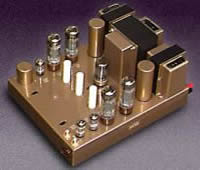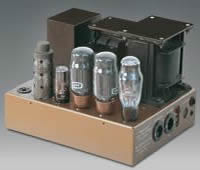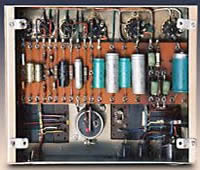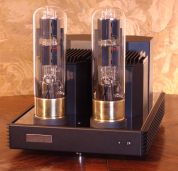Valve technology is the most elegant means by which music can be amplified to drive a speaker. This is not because valves have magical qualities but because the technology by which they function is not achievable by other means. A thousand years from now, valve amplifiers may be the only technology from the 20th century, that will be loved with as much passion as when first created.
Classic valve amps Leak and Quad are representative of many classic British names of valve amplifiers that were built to achieve the highest fidelity and were excellently constructed. McIntosh and Fisher were well known US brand names.


 These amplifiers are described as Class AB push pull. 2 Output valves per channel. The amplifier in the center is mono. These mono amplifiers were extensively used for monitoring in broadcasting studios as well as in pairs for recording studios. Leak amplifiers are lovingly restored and maintained by dedicated enthusiasts.
These amplifiers are described as Class AB push pull. 2 Output valves per channel. The amplifier in the center is mono. These mono amplifiers were extensively used for monitoring in broadcasting studios as well as in pairs for recording studios. Leak amplifiers are lovingly restored and maintained by dedicated enthusiasts.
www.rewindmuseum.com/valve amplifiers
www.leak-hifi.co.uk/our-story
www.quad-hifi.co.uk/our story
www.mcintoshaudio.com/repairs
History. Before solid-state technology existed, the majority of domestic valve radios and radiograms were manually assembled by large teams of women in often appalling conditions that would not be accepted today. Designs were scrutinied to reduce manufacturing cost. Valve count kept to minimum, cheapest components used at voltage rating limits, safety standards almost non-existent. The heart of a valve amplifier is the output transformer which comprises most of the mass, bulk, cost and difficulty of making the amplifier. Output transformer size and therefore performance was kept to minimum. Only a few amplifier brands were well made to achieve the highest technical performance.
By the 1960s valve technology began to leap forward, but too late. Sold-state (transistor) technology arrived and manufacturers competed to be first to make the change. Solid-state technology reduced size and costs (no output transformers). Production became mechanised onto printed circuit boards, staff was reduced and profits escalated. The intense marketing of solid-state amps caused valve amps to be perceived as worthless, except for musicians. Virtually mountains of valve radios, radiograms and valve HiFi amplifiers ended up in the landfills of our expanding cities.
The first solid-state Hi-fi amps used Germanium which performed poorly, were un-reliable and limited to low power. When Silicon transistors were invented the circuits became refined and solid-state amps became reliable. However, it took approx 20 years of research and development for solid-state amps to equal and in some ways outperform the best valve Hi-fi amps. The stigma of the poor performance and un-reliability of the original solid-state amps evolved into a mythical dark cloud that continues to haunt the hi-end Audiophile market of today.
Waste and redundancy Most modern solid-state electronic technology is redundant within a few years of purchase and then discarded. During the past era when only valve technology existed the concept of waste and redundancy did not exist. A vast service industry maintained all valve electronic technology to its maximum life. The most common service was replacing valves. The thermal noise, as hiss, generated by valves plus the problem of microphonics and in-consistent gains and constantly needing to adjust the balance between left and right in stereo systems, was a major source of annoyance to every discernible connoisseur of music. Recording studios, radio and television stations had a constant rotation of valve equipment being calibrated and serviced.
Occult audiophilism
Occult audiophile claims about valves having a magical warm sound began in the 1980s nearly 20 years after solid state technology took over. By paying attention to this illogical use of language, the assumption is, by putting an audio signal through an infinite number of valves and an infinite length of magical cable, the sound will become infinitely warm and infinitely magical. This type of dumb marketing hype would have been viewed as a joke, in the previous era, when all amplifiers were valve.
Valve sound. No valve should have its own sound. If it does, then the added distortion is imposed on the music where it does not belong. There is a vast amount of misinformation on the web about various valves having individual characteristic sounds. This is only true when a particular valve (valve A) biased to give optimum performance is substituted with another valve (valve B) with the same pin configuration with different internal parameters. Therefore the biasing that was used to correctly center valve A in its linear operating position does not apply to valve B. The majority of differences heard are simply gain related, no different than if the volume (level) is changed slightly. Other differences are to do with valve B operating outside of its linear region and the difference heard is excessive 2nd harmonic distortion.
However, valve amplifiers do interact differently with speakers compared to conventional solid-state amps and the resultant audible difference we notice is explained in valve/solid-state page.
Myths. To appreciate valve amplifier technology we must first debunk audiophile myths that incorrectly describe them. Many Audiophiles believe in alchemy and behave similar to religious cults. Cult driven audiophiles are easily identified by their repetitious chanting of brand names, model numbers and meaningless superlatives concocted by high priest reviewers
 and marketing spin doctors. The highest Deity worshiped by the occult audiophile is the Single ended Class A valve amplifier. These amplifiers have one 1930s style large triode per channel. They are extremely inefficient, average 3 to 20 Watts and often generate excessive 2nd harmonic distortion. The reason for worshiping one output valve is the same reason the religions of Abraham worship one God. These single ended amplifiers can be decorated with gold, and interconnected with oxygen-free cable which channels
Orgone
energy (un-used sexual energy) from the lost city of Atlantis, enabling anything connected to the cable to transcend the laws of physics. Many of these cult objects are faddish nonsense and a few are beautiful works of art. The right pic is the KronzillaSX amplifier by
KR Audio.
and marketing spin doctors. The highest Deity worshiped by the occult audiophile is the Single ended Class A valve amplifier. These amplifiers have one 1930s style large triode per channel. They are extremely inefficient, average 3 to 20 Watts and often generate excessive 2nd harmonic distortion. The reason for worshiping one output valve is the same reason the religions of Abraham worship one God. These single ended amplifiers can be decorated with gold, and interconnected with oxygen-free cable which channels
Orgone
energy (un-used sexual energy) from the lost city of Atlantis, enabling anything connected to the cable to transcend the laws of physics. Many of these cult objects are faddish nonsense and a few are beautiful works of art. The right pic is the KronzillaSX amplifier by
KR Audio.
Audionote has a range of single ended amplifier DIY kits showing their internal construction.
Some single ended valve amplifiers today, including replications of early triode valves are made by enthusiasts demonstrating the craft and skills similar to enthusiasts who replicate old grandfather clocks and steam engines. Some of these hand crafted single ended amplifiers are highly valued by collectors and as stated earlier can be beautiful works of art. This craft of demonstrating the skills to create technology of the past must not be confused with modern technology and science.
S.E.T. (Single ended Triode) Possibly the most asked question is the confusion between Class A single ended (1 output valve amplifiers) and Class AB push pull (2 output valves per channel amplifiers). Before the 1960s most small radios and radiograms were made as cheaply as possible, minimum number of pre-amp valves with one output valve (Class A) that delivered 2 to 3 Watts of power. The higher quality, more expensive radiograms that were marketed as genuine Hi-fidelity had 2 output valves in push pull (Class AB), achieving lower distortion with a greater frequency response and were 10 to 30 Watts per channel. The difference between a cheap (Class A) 1 output valve amplifier and a more expensive push pull (Class AB) 2 output valves per channel amplifier, was greater power, fidelity and an impressive bass response.
Leak, Quad, Mullard, McIntosh, Fisher, never made SET valve amps. This idea to them would have been an abomination. They only made Class AB amps. Maybe they were ignorant not to realise that if they removed one output valve, their amps would have sounded magical to those who regard themselves as occult audiophiles. It appears these early valve amp manufacturers were blindly obsessed with making amps that created no sound of their own.
 Occult audiophilism may have began in Japan in the 1980s. This nonsense has partially destroyed the credibility the audiophile market and turned it into a laughing stock. Single ended (1 output valve / channel) amplifiers can be priced as high as $100,000 including $1,000 / meter Magical cable. Alchemistic audiophile occultism is also sustained by unethical audiophile reviewers. The best analogy for demonstrating the difference between a single ended valve amp SET and a Class AB valve amp, is riding a push bike using one leg, compared to using both legs.
Occult audiophilism may have began in Japan in the 1980s. This nonsense has partially destroyed the credibility the audiophile market and turned it into a laughing stock. Single ended (1 output valve / channel) amplifiers can be priced as high as $100,000 including $1,000 / meter Magical cable. Alchemistic audiophile occultism is also sustained by unethical audiophile reviewers. The best analogy for demonstrating the difference between a single ended valve amp SET and a Class AB valve amp, is riding a push bike using one leg, compared to using both legs.
You tube / Riding the rollers - one leg no hands
You tube / Bike messenger rides with one leg
Why are occult audiophiles opposed to double blind testing ?
The word occult comes from the Latin word occultus (clandestine, hidden, secret) referring to "knowledge of the hidden". wikipedia.org / occult.
Double blind testing is a science based practice, which cross checks the observer or listeners accuracy when paying attention to the external nature of reality. Occult practitioners (representing freedom from self doubt) are not concerned with external reality, but only with internal reality. The internal reality of nature can only be discovered through blind faith or belief, with the assistance of a guide. A guide (priest or reviewer) is someone who's faith and belief is confirmed by the majority.
Scams. Many stock market traders in Wall St and London (before the bubble burst) were cocaine addicts and soft targets for fake gold watches, SET amps and audiophile magical cable etc. A large percentage of antiquities including art works on eBay have been exposed as fakes. Other known scams are re-labeling and adding dust to valves to look as though they are pre 1960s originals. Scams including fake 1960s Fender Stratocasters and Fender guitar amps are also clever. Some people who have been conned by scams accept with humility that ignorance and ego was their undoing. But what we often see is the social, corporate and political behaviour of those who do everything in their power to avoid looking stupid and deny, deny, deny.
Soothsayers, charlatans, occult believers and peddlers of misinformation have not disappeared, they are still among us today making a living as unethical audiophile reviewers and resellers. Understanding valve amplifiers, requires us to have an appreciation of science, an historical perspective and a respect for engineers (not unethical HiFi reviewers) who committed their lives to researching valve amplifier technology to achieve the best technical performance.
The comments that Rod Elliott and I write are intended to direct humour at an industry we see fails to be objective. It appears to us that the audiophile and professional sound re-enforcement industries are the last industries that evolved from the industrial revolution that have yet to free themselves from the entrapment of alchemy and the occult.
The underlying issue we are dealing with is not the retail sector of the audiophile industry, but many of today's self proclaimed audio engineering fraternity who willingly sell out their personal and professional integrity (similar to politicians) for what they know is false.
Rod Elliott has his own way of describing SET amps. "I think that SET owners need to have access to serious information that discredits their chosen amp. I describe the SET amp as an "effects unit" rather than a hi-fi amplifier, since it fails to meet even the most generous definition of hi-fi in all significant respects. This is a reasonable and accurate description. Naturally, if people wish to use the "effects unit" that's entirely up to them, and if they enjoy it, that's perfectly fine. What they must *not* do is try to convince me or anyone else that they have a hi-fi setup, because they don't".
sound-au.com / valves
Basic differences between valve and solid-state amps
- Valve amps are high cost, high mass, electronically robust, but mechanically fragile.
Solid-state amps are low cost, low mass, mechanically robust, but electronically fragile. - Valve amps naturally tend to maintain constant power into a varying speaker impedance.
Solid-state amps can not maintain constant power into a varying speaker impedance. - Shorting the speaker lead has almost no detrimental effect on valve amps.
Shorting the speaker lead can easily destroy some solid-state amps. - Reactive impedance of cables, speakers and crossovers has minimal effect on valve amps.
Reactive impedance of cables, speakers and crossovers can disrupt many solid-state amps. - The valve amp output transformer acts as a buffer between amp electronics and the speaker.
Solid-state amp electronics are directly connected to the speaker. - Electronic faults within valve amps can not be transferred to the speaker.
Electronic faults within solid-amps (particularly DC latching) can destroy the speaker.


